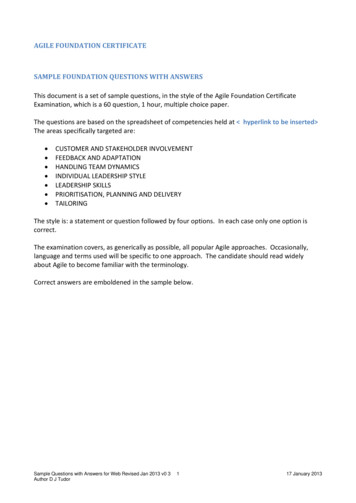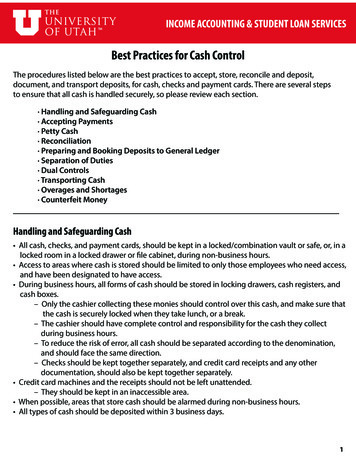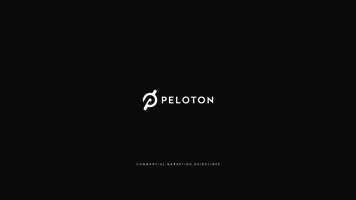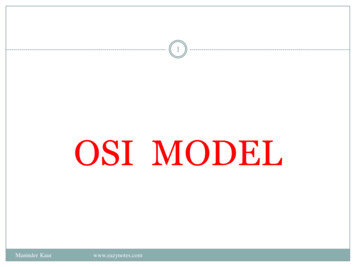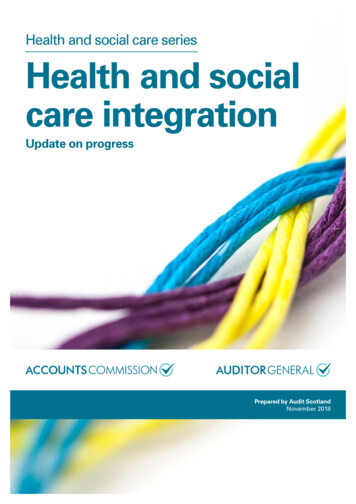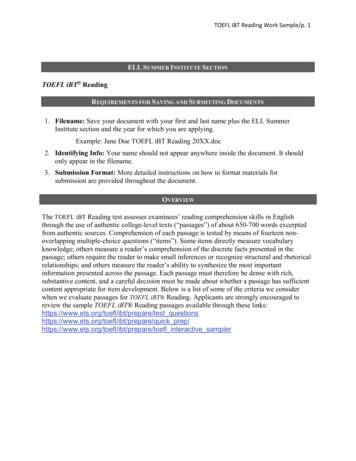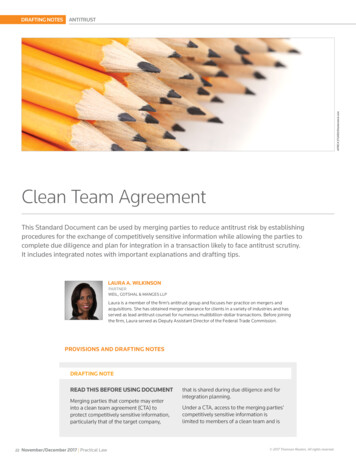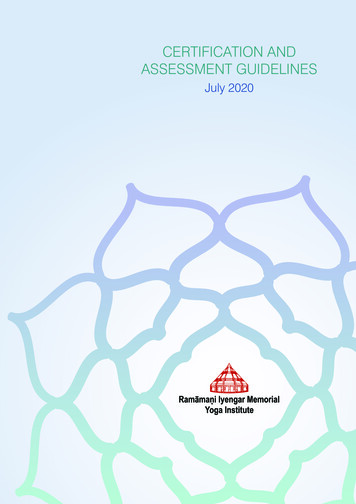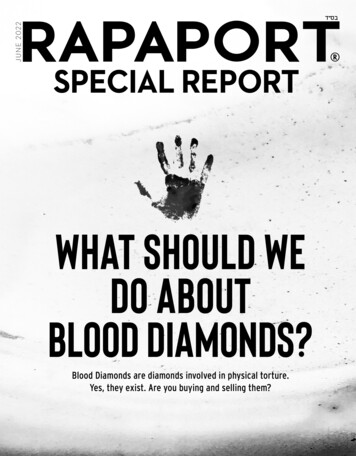
Transcription
J U N E 2 02 2SPECIAL REPORTWHAT SHOULD WEDO ABOUTBLOOD DIAMONDS?Blood Diamonds are diamonds involved in physical torture.Yes, they exist. Are you buying and selling them?
March 24, 2022Dear readers,This special report, “What Should We Do About Blood Diamonds?”was created before the Russian invasion of Ukraine. The issue of blooddiamonds is now reaching a broader audience following sanctionsby the US and Western allies on the Russian government ownedAlrosa diamond mining company. While Alrosa has taken responsiblepositions regarding blood diamonds in the past and their letter isincluded in this report, the fact that it is 33% owned by the Russiangovernment that funds the war has caused it to be excluded fromdiamond trade organizations.And yet even with all the attention on Alrosa and the horriblesituations in Ukraine, the terrible problem of blood diamonds inMarange, Zimbabwe and other locations persists. Our diamond tradeis not only failing to stop the torture of innocent people, worse yet, ithas become acceptable and routine for members of the trade to buyand sell these blood diamonds. How can this be?For a long time the diamond leadership and organizations havesupported the Kimberley Process (KP) and in fact continue to do so(see Pages 20 to 21 of this report). Our trade organizations proudlyproclaim our diamonds are KP non-conflict or KP conflict-free,misleading consumers who think that these diamonds are free ofhuman rights abuses. Bad enough that the KP is not stopping humanrights violations. But worse, much worse, the KP is proactivelycertifying and legitimizing the sale of blood diamonds. It is making itpossible for those behind the torture to sell their blood diamonds intothe legitimate diamond supply chain and then legally collect payment.It is poisoning the well from which we all drink. It is supportingtorture. This is beyond the red line. There is no justification forsupporting and enabling organizations that support torture.Now that the KP continues to certify Marange and other blooddiamonds. Now that the KP certifies Russian sanctioned diamonds.Now that Zimbabwe is scheduled to be the chair the KP. It is timefor the diamond trade leadership and organizations, and the WorldDiamond Council (WDC) in particular, to disengage from the KP.Yours truly,Martin RapaportCHAIRMAN, RAPAPORT GROUP1
THE KIMBERLEY PROCESSCIVIL SOCIETY COALITIONThe Kimberley Process Civil Society Coalition is agroup of civil society organizations from Cameroon,Democratic Republic of Congo, Central African Republic, Guinea, Ivory Coast, Liberia, Lesotho, SierraLeone, Zimbabwe and Belgium. As an NGO watchdog to the Kimberley Process, we hold this schemeaccountable for its failings to stop the trade in conflict diamonds.We work on a daily basis with communities affectedby diamond mining to empower them in claimingtheir rights. By bringing grassroots evidence andcommunity testimonies to governmental, corporateand civil society stakeholders on the national and international level we strive to promote and improveresponsible diamond governance across the valuechain.We strongly believe that closing the information gap andcreating meaningful relationships between the communities at the birthplace of diamonds and those who market and sell them is essential in maximizing the benefitsand minimizing the harms associated with diamondmining.Find out more about our work and join the fight for amore responsible diamond trade via kpcivilsociety.org
What shouldwe do aboutblooddiamonds?C OV ER S TO R YLEG A L4 Analysis by Martin Rapaport30 How US law intersects with human rightsin the jewelry industryREP OR T S32 US sanctions: FAQ on OFAC and customs10 Torture in Zimbabwe14 Blood diamonds in the supply chain18 The Kimberley Process Civil SocietyregulationsD O ING G O O DCoalition33 Standards to live by: Tools from the RJC34 Indian outreach: How the country’sINDU ST RY V I E W Sdiamond sector is giving back2 0 World Diamond Council (WDC)2 2 Global Witness2 3 Responsible Jewellery Council (RJC)2 4 De Beers26 Signet Jewelers26 Tiffany & Co.2 7 Alrosa28 United States Jewelry Council (USJC)2 9 Dubai Multi Commodities Centre37 Leading the positive charge: Groupsmaking diamonds a force for good39 Rapaport’s social responsibility directory(DMCC)3
note from the publishersDNOMAIDBLOODBlood diamonds are diamonds involved in tortureor slavery.There is no justification for the buying andselling of blood diamonds.Yet that is what our industry is doing. Wecover it up by pushing misleading terminology like “conflictfree” or “non-conflict,” which implies diamonds are legitimatewhen they are blood diamonds. As an industry we supportevil governments through the Kimberley Process (KP), whichcertifies blood diamonds as legitimate, giving them directand easy access to our trading and cutting centers. These KPcertificates also legitimize the money received from the saleof these diamonds. The KP is the washing machine for dirtydiamonds and dirty money. Shockingly, the KP is supportedby the World Diamond Council (WDC) and its memberorganizations.And so, the torture goes on and on. For years the diamondindustry has been trading Marange blood diamonds. Thetorture, KP certifying, and trading has become routine, normaland acceptable. It’s no longer shocking. Just another day,another deal, another victim. This must stop.In spite of this terrible situation, the diamond industry doesmuch good. Thousands of people and dozens of organizationsare working hard to make the world a better place. Our tradeis doing good things for the disadvantaged members of ourindustry, including artisanal diggers who are getting effectivesupport from organizations like the Alliance for ResponsibleMining (ARM), De Beers GemFair and many others. We area caring, loving industry with good people who intensely careabout others.So how do we solve the problem? How do we keep blooddiamonds out of our legitimate diamond supply chains? Whatshould we do? That is what this issue of Rapaport Magazine isabout. We are all in this together. There are many views. I willpresent mine and so will others. So read on. Get involved withthis issue. Visit our social responsibility website sr.rapaport.com.Contact me at sr@rapaport.com.I believe in the goodness of our trade and its people. But I amworried about how we are handling the blood diamond issue. Wemust take action. We must stop trading blood diamonds.Martin RapaportPUBLISHERM A RT IN @RA PA P ORT.COM4
COVERWhat shouldwe do aboutblooddiamonds?Blood Diamonds are diamonds involved in physical torture.Yes, they exist. Are you buying and selling them?BY M A R T I N R A PA P O R T5
COVERBlood diamonds are diamonds involved intorture or slavery.This Blood Diamond Report includessections about severe human rightsviolations, industry views, legal comments,and good things the jewelry industry is doing. I thank all thosethat have provided information and appreciate their concernfor human rights in the jewelry industry. Writing about blooddiamonds is very difficult. Doing something about it is evenharder. The purpose of this special report is to raise awarenessand stop the trade in blood diamonds.It’s hard not to get emotional. To cry out. To name, shameand blame. But that will not solve the problem. We mustprovide solutions. As you read this, people are being tortured,yet we must take a rational approach and engage the industryleaders so they take necessary action. While I will expressmyself forcefully and even harshly, the goal is to solveproblems, not criticize.A lot of good people are doing a lot of good things. Weneed to encourage them, recognize them, support them andbe them. But doing good alone does not solve the problem ofblood diamonds. We must understand that just because manyof us are doing good things, it does not excuse us or othersfrom trading blood diamonds.DUE TO HUMAN RIGHTSABUSES, DIAMONDSHAVE LOST THEIR INNOCENCEAND PRESUMPTIONOF GOODNESSthe diamonds they buy. However, most of the trade does notyet do this. We trade diamonds from unknown sources. Someidentify bad diamonds and exclude them. For example, theUS government and RapNet ban diamonds sourced fromZimbabwe’s Marange fields but don’t insist that all diamondsimported into the US or listed on RapNet be source identified.Ten companies mine about 84% of the world’s diamonds. Wemust identify the good companies and their good diamonds.We must publish a list of “good” mines. Then we must trace thediamonds through production using blockchains and sourcecertify the polished diamonds.Our initial goal should be to identify bad diamond sourcesand exclude them from our supply chains. At the same time,we should expand our identification, documentation andcertification of good diamonds from good sources. It’s atwo-pronged effort: Exclude the bad diamonds and documentthe good ones. That’s the key to legitimizing the diamondsupply chain.The ability to document and certify good diamonds requirescompliance with standards that include three basic elements. 1)A legal commitment related to the sale of the specific product,2) independent auditing of implementation and 3) enforcementif standards are violated.The World Diamond Council (WDC) suggests a three-layerapproach to ensure ethical supply chains. The first is theWDC System of Warranties (WDC-SoW). The second is theResponsible Jewelry Council Code of Practices (RJC-COP).The third layer is additional company standards such as theSignet Responsible Sourcing Protocol (SRSP) and additionalstandards from organizations such as the Initiative forResponsible Mining Assurance (IRMA).THE C OVID-19 C OMPARIS ONThink of blood diamonds as a new Covid-19 virus. Even thoughthere are good people doing a good job curing cancer — thatdoes not solve the Covid-19 problem. We don’t blame the peopleworking on cancer for not solving Covid-19. Yet we know wemust find a solution. We can try to cure Covid-19, but in themeantime we must protect ourselves from getting it and ourcommunity from spreading it.We wear masks to protect ourselves from Covid-19 and isolateourselves so as not to spread it. We don’t assume everyone isOK; we take tests before boarding planes or entering countries.When it comes to Covid-19, you are guilty until proven innocent.So too with diamonds. Due to human rights abuses, diamondshave lost their innocence and presumption of goodness. Weare moving to a new reality where diamonds are guilty untilproven innocent. Sure, most diamonds do good and most peopleare healthy, yet as a societywe ask the question: Are youOK? Consumers are now beingtrained to question: Are yourdiamonds OK? Where did theycome from?20kApproximately 20,000people live in Zimbabwe’sMarange regionFIXING THE SYSTEMThe requirement to knowwhere every diamond comesfrom is an emerging process.Brands such as Tiffany &Co., Forevermark and othersalready source identify all6
COVERA key question is the effectiveness of the SoW and COPstandards relative to blood diamonds. While a thoroughanalysis of the SoW and COP standards is beyond the scopeof this report, we plan to publish a detailed report about howthese standards relate to the three basic elements definedabove and their ability to exclude blood diamonds from thediamond supply chain.THERE IS NO ASSURANCETHAT CONFLICT-FREEDIAMONDS OR KP-CERTIFIEDDIAMONDS ARE NOTBLOOD DIAMONDSMARKET IMPACT OF NEW STANDARDSEdward Asscher remarked at the 2021 Kimberley Process (KP)intersessional that “in the not-too-distant future, there will bea difference between rough diamonds that can be guaranteedto have fulfilled the consumers’ demands and expectations,and other diamonds. Responsibly sourced diamonds willbe more in demand. They will obtain better prices in themarketplace, and buyers at jewelry stores will demand proofthat they are indeed responsibly sourced before purchasingthem as polished.”Asscher pleaded for the establishment of KP standardsthat would meet consumer expectations so that “all naturaldiamonds from all participating countries” would beacceptable to consumers and that “no one should be leftbehind.” But that’s not going to happen. The KP will notchange the definition of conflict diamonds and/or createstandards that eliminate blood diamonds from their supplychain. It’s not in their interest to do so.The diamond market will split between responsibly sourceddiamonds and diamonds from unknown sources. This presentspolitical problems for the bourses. Speaking to the KP on June25, 2021, Asscher said, “Small and medium-sized enterprises[SMEs] will experience difficulties selling natural diamonds,because they do not belong to the elite group of polishers thatcan guarantee that the diamonds they source and polish areresponsibly sourced. That will create an unlevel playing field inthe polished centers, and threaten the livelihoods of thousandswho own, are employed [by] or service SMEs.” Asscher iscorrect, but he is asking the wrong people for help. The KP willnot eliminate blood diamonds from the diamond supply chain.The SME problem we face will require the developmentand implementation of new tracing and tracking technologythat assures an ethical supply chain. It will be an added-valueproposition, given the fact that buyers are willing to pay morefor documented diamonds.CERTIF YING BLO OD DIAMONDSThis brings us to a very difficult discussion. When asked,“What should we do about blood diamonds?” the title ofthe WDC response was “Position of the diamond industryorganizations in relation to the Kimberley Process.” The firstparagraph states, “We the undersigned diamond industryorganizations, all represented by the World Diamond Council(WDC), are categorically committed to protecting the ethicalintegrity of the natural diamond and the diamond supplychain, doing all within our power to prevent them from beingassociated with violations of fundamental human rights. Aspart of this ongoing effort, we affirm the critical role beingcarried out by the Kimberley Process (KP).”But the KP has nothing to do with blood diamonds. Asscherwas honest when he stated in his blog of September 2, 2021,that “the KPCS is unfortunately limited in scope. Unless thatis expanded, it cannot be expected to be a panacea to otherchallenges afflicting artisanal diamonds, including human andlabor rights violations, bribery and corruption.” THE DIAMOND MARKETWILL SPLIT BETWEENRESPONSIBLY SOURCEDDIAMONDS AND DIAMONDSFROM UNKNOWN SOURCES7
COVERThe WDC can no longer ignore the trade in Marange blooddiamonds and make believe they don’t know what is going on.The WDC has been asking the KP to help stop the flow ofblood diamonds. Doesn’t the WDC realize that governmentofficials make and launder millions of dollars on the sale ofKP-certified blood diamonds?We must face the fact that the KP has blood on its handsand still enjoys WDC support and legitimization. What musthappen before the WDC stops supporting KP certification ofblood diamonds and their distribution in our supply chains?When will the WDC and all its member organizations ban thetrade in Marange diamonds and expel members who tradethem? Does the WDC have any red lines? If so, where are they?THE KIMBERLEY PROCESS IS THEPRIMARY FORCE PROMOTINGTHE SALE AND DISTRIBUTION OFBLOOD DIAMONDS. IT IS THEWASHING MACHINE FOR DIRTYDIAMONDS AND DIRTY MONEYNAME GAMESThe definition of “conflict diamonds” is limited to diamondsthat fund civil war. It does not include diamonds involved inhuman rights violations such as torture, rape, or slavery. Theuse of terms like “non-conflict” or “conflict-free” to implythat diamonds are not involved in human rights abuses ismisleading, dishonest and unethical.When we guarantee that diamonds are “conflict-free,” weare relying on a legal Kimberley Process technical definition tofool ourselves and our customers. There is no assurance thatconflict-free diamonds or KP-certified diamonds are not blooddiamonds.If we want to stop the trading of blood diamonds, we mustcommunicate honestly about them. If diamonds are legitimateor ethical then that is how we should describe them. It’s timeto stop the misleading name game.If blood diamonds are outside the scope of the KP, why do allthe diamond industry organizations, including the WDC, RJC,World Jewellery Confederation (CIBJO), World Federationof Diamond Bourses (WFDB), International DiamondManufacturers Association (IDMA) and Natural DiamondCouncil (NDC), “affirm the critical role being carried out bythe Kimberley Process?” In fact, what role does the KP playregarding blood diamonds?The KP is the primary force promoting the sale anddistribution of blood diamonds. It certifies blood diamondsas legal and legitimate. Blood diamonds with KP certificateshave direct and easy access to the diamond trading and cuttingcenters. KP blood diamonds are mixed with legitimate roughand polished diamonds and then sold on to consumers. Themoney that is then paid for these KP-certified blood diamondsalso becomes legitimate. The KP is the diamond market’s dirtyback door. It is the washing machine for dirty diamonds anddirty money. It is run by governments for governments, someof which are corrupt.Some leaders deny that the KP certifies blood diamonds.Consider Zimbabwe. According to the KP, in the five yearsfrom 2016 through 2020, Zimbabwe exported 10,393,517 caratsof diamonds worth 550,129,022. It is estimated that 80% ofthose diamonds originate in Marange. That’s 440,103,218.If Zimbabwe’s KP-certified diamond exports did not comefrom Marange, where did they come from? And where didthe money go? How much of Zimbabwe’s KP exports are fromMarange? Does the KP certify blood diamonds — yes or no?The WDC must answer these questions.Denying the role the KP plays in legitimizing blooddiamonds is dishonest, unacceptable, unethical, and totallywrong. It goes against everything decent our trade stands for.WHO IS RESP ONSIBLE FOR BLO OD DIAMONDS?Is it the guard or police officer who pulls the trigger or setsthe dogs on the victim, the company that hires the guards, thegovernment that allows its army or police to torture people,the rough diamond buyer, the cutter, the polished dealer, theretailer, the consumer — who is responsible?BUYERS ARE WILLING TOPAY MORE FOR DOCUMENTEDDIAMONDS8
COVERThe WDC position is that addressing “human rights risks isthe individual responsibility of every business that operates inthe diamond sector.” The RJC “believes that supply chain duediligence is the responsibility of each and every company in theglobal jewelry industry.”So everyone is responsible. That is, everybody except thetrade organizations that set standards and fail to enforce them,or governments that encourage human rights abuses. It’s notfair, but the bottom line is that you and you alone are 100%responsible for what you buy. You can’t pass this responsibilityto trade organizations or governments.YOU AND YOU ALONE ARE100% RESPONSIBLE FORWHAT YOU BUY. YOU CAN’TPASS THIS RESPONSIBILITYTO TRADE ORGANIZATIONS ORGOVERNMENTSWHAT SHOULD A US JEWELER D O?The first step is to recognize that money is power and youcan use it to transition to a more ethical supply chain. Next,recognize the world is not perfect and it will take time andeffort to improve your supply chain. While doing this becareful to maintain the profitability of your business. Reviewyour customers’ appetite for social responsibility and the costsinvolved. Don’t be afraid to charge more for what costs more.Communicate your social commitment, market the benefit youare providing and charge a fair price.Review your suppliers and decide who can help youtransition. Tell them to help you exclude blood diamondsfrom your supply chain. A good place to start is by requiringthem to provide a written guarantee that the diamonds theyare selling you are not from Marange. Encourage them to getsimilar written commitments from their suppliers.Recognize that even good, ethical suppliers are not goingto be able to document every diamond they sell you. At thisstage they might not know where all their diamonds comefrom. You should still make sure you get written documentsensuring legitimacy. They can give you information suchas whether their supplier is an RJC member or a DeBeers sightholder. Recognize that transitioning to a moreethical supply chain is a process. You need to partner withsuppliers and communicate honestly and openly as youdevelop relationships. Suppliers should be as interested intransitioning to an ethical supply chain as you are. Workwith them.How is a jeweler in California to know about human rightsviolations in Zimbabwe? Stay informed. Visit sr.rapaport.com forresource information and contacts. We strongly recommendthat you join the RJC at responsiblejewellery.com and interactwith its members.investigated and publicized. If the KP does not stop certifyingblood diamonds, the WDC must disengage from the KP.The role of the WDC and the RJC standards must beclarified to ensure there is no greenwashing of blood diamondsthrough the use of misleading standards or terminology. TheWDC should be encouraged to transcend the KP and focus onits goal of ensuring a legitimate diamond industry. This shouldinclude the exclusion of bad actors and bad diamonds fromtheir member organizations.This has been a difficult article to write and experience.The suffering of blood diamond victims cries out. Thebanality of blood diamond business as usual is unsettling.The continuous flow of blood diamonds into the diamondsupply chain horrifies me and makes me question thelegitimacy of our diamond trade.I know most diamonds do good and the leaders of ourindustry are good people doing good things. I know we mustnot blame our leaders for trying their best to solve difficultsituations. Our leaders need to be thanked, not criticized.So let’s not take this article as criticism. Let’s consider itan urgent request for change from someone with a differentperspective.Friends, we have to do more. The cries of suffering andinjustice call out to us. We are responsible for what we buy.We are responsible for the unintended consequences of ouractions. There must be less talk and more action. We must dosomething, anything, and everything to stop the cycle of blooddiamond violence and injustice.There is a reason G-D gave diamonds to the poorest peoplein the world and made the richest desire them. The role of thediamond trade is to bridge this gap. That is why we exist. Ourtrade is doing G-D’s work. Tikkun olam — fixing the world. C ONCLUSIONThis article raises many important issues. Chief among themis the setting of standards that ensure the diamond industrydoes not trade blood diamonds. These standards must be welldefined so as not to leave room for greenwashing. They mustinclude independent auditing, and be enforced by excludingmembers that violate the standards.The role of the KP in relation to the certification andlegitimization of blood diamonds and corruption must be9
REPORTtortureinewbabZimThis report was obtained through confidentialsources. All names and initials have beenchanged to protect the identity of the peopleinvolved. Many people are afraid to disclose whathappened to them for fear of retribution by theauthorities. Additional evidence about humanrights in the diamond industry is available atsr.rapaport.com10
REPORTTMost of the reported violations were committed byprivate security guards of the Zimbabwe ConsolidatedDiamond Company (ZCDC), but also by police and militaryofficers. They have predominantly targeted those looking fordiamonds or panning inside and outside the concessions.Their testimonies reveal that the rule of law does not existin Marange.Public as well as private security forces play a dubious role,as they both organize illegal syndicates that mine for diamondsand impose brutal punishments on those who do not play bytheir rules. They severely torture artisanal miners who have notpaid protection money. Various miners showed severe injuriesinflicted by guards who had beaten or set vicious dogs on themwhile they were handcuffed. After long sessions of torture,victims said, they were loaded onto trucks and abandoneddeep in the forest. The mostnotorious security guardswhose names the minersmentioned were Gumbo,Lewis, Bepete and Matanda,who is now disabled afterartisanal miners crushed hisleg in a revenge mission.As this scare campaign ispresumably authorized bythe highest echelons of powerin Zimbabwe, perpetratorsenjoy total impunity, whilevictims have no recourse toa remedy. Spreading evenmore fear, ZCDC guards,army and police reportedlyraid public markets in searchof diamonds on occasion.They indiscriminately andextrajudicially arrest localsand take them to detentioncenters at the so-calledDiamond Security Bases,where they must pay a fineor bribe their way out. Thosemen and women who fail to pay are subjected to forced laborand detained for days in a cramped and mosquito-infested5- by 2-meter cage that only provides partial shade and hasno toilet.Artisanal miners and state security officials interviewedduring the investigation estimated that between five and10 people are either bitten by dogs or tortured every day,while over 30 are rounded up and detained per week acrossthe diamond field. Most cases go unreported and remainundocumented because the miners are afraid of beingidentified and arrested for trespassing. Those who have sufferedinjuries do not even seek medical treatment at health facilities,because nurses ask them to produce police reports before staffwill attend to them. he people of Marange, Zimbabwe, have seenlittle good from the enormous diamond wealththat was discovered in their lands. In 2006,a diamond rush by thousands of artisanalminers met with a violent crackdown fromgovernment forces, resulting in the loss of over 200 lives andthe forcible eviction of 1,500 families. The government thenrestricted access to this 795,000-hectare zone by designatingit a protected area. It awarded most of the land to a rangeof mining companies in dubious deals that served to concealgovernmental elites’ siphoning of diamond revenues.The approximately 20,000 people still residing in Marangelive a difficult life. Their freedom of movement and associationis curtailed, with roadblocks on all access roads and completemilitarization through widespread police, army and privatesecurity patrols. Their livelihoodoptions have been drasticallyreduced, as mining concessionsoccupy the land where theyused to crow crops, herdlivestock, or fetch water andfirewood. They live in constantfear that they or their familymembers will become victims ofthe regular assaults, harassmentand intimidation that securitybrigades inflict on locals,including women and children.These difficult conditionshave led many — mainly youngmen — to look for diamondsin their ancestral land, fromwhich they derive little or nobenefit now that it has beenawarded to mining companies.With public and privatesecurity forces known to usebrutal violence, intruders areaware that they’re risking theirlives, but they see no otheroptions to make ends meet.The cruelties have given Zimbabwean diamonds a badreputation internationally. Various major retailers have bannedthem from their supply chains, and in 2019, US Customs andBorder Protection issued a withhold-release order for Marangediamonds over suspicions of forced labor. This prompted theZimbabwean government to launch a charm offensive, whichculminated most recently in the acceptance of its bid to chairthe Kimberley Process (KP) in 2023.Claims by the government are difficult to verify, as accessto Marange is restricted, with civil society and independentobservers particularly unwelcome. Yet in the first weeks of2022, we managed to collect direct testimonies from localsin Marange. These reveal that little has changed there, andhuman rights violations continue unabated.VARIOUS MINERS SHOWEDSEVERE INJURIES INFLICTEDBY GUARDS WHO HAD BEATENOR SET VICIOUS DOGS ONTHEM WHILE THEY WEREHANDCUFFED11
I N J U R I E S : Wounds from dogbites on arms and hands.TESTIMONYI N J U R I E S : Wounds from dog bites on the arm.N A M E O F VI CT I M : C O L L EN ( P O L I C E O FFI C E R) A N D SI X OT HER SAGE: 33TIME OF OCCURRENCE: DECEMBER 23, 2021, 2 A.M.PLACE OF OCCURRENCE: CRUSHER 2 (ZCDC CLAIM)TESTIMONYNAME OF VICTIM: ANESU KASEKE (FORM 4 STUDENT)AGE: 18T I M E O F O C C U R R E N C E : J A N U A R Y 5 , 2 0 2 2 , 2 P. M .PLACE OF OCCURRENCE: DEBMAR (ZCDC CLAIM)BRIEF DESCRIPTION:As a police officer, Collen was deployed to the Marangediamond fields sometime in 2021. In October 2021, hisgroup was recalled and another group from a differentstation brought into Marange as a replacement. Like manypolice and military officers deployed in the diamond field,he had established his own syndicate that he was workingwith. Upon returning to his station, which was furtherfrom Marange, he immediately applied for vacation leave.He left his workstation and sneaked back into Marange.On December 23, 2021, Collen and his syndicate of sixartisanal miners were apprehended by ZCDC securityguards at the Chitubu area within the diamond field. Theguards set dogs on them, and five sustained deep injurieson their arms and hands. They never reported the incidentto the police or sought treatment from any health facility.Collen confirmed that state security officials (policeofficers and soldiers) deployed in the diamond field runnumerous syndicates. However, he said, generally, statesecurity officers do not trust the artisanal miners becausethere is no guarantee that they will always be honest anddeclare all the diamonds they would have found.“Each syndicate will have two or three statesecurity officers, and they take turns to accompanyartisanal miners. This helps in monitoring and ensuringtransparency,” he said. Collen said this was the reason hesneaked back into the diamond field, because he feared thatpeople whom he sponsored might discover a diamond andsell it without informing him.Asked about the
CHAIRMAN, RAPAPORT GROUP 1 March 24, 2022 D ear readers, This special report, "What Should We Do About Blood Diamonds?" was created before the Russian invasion of Ukraine. The issue of blood diamonds is now reaching a broader audience following sanctions by the US and Western allies on the Russian government owned Alrosa diamond mining company.
